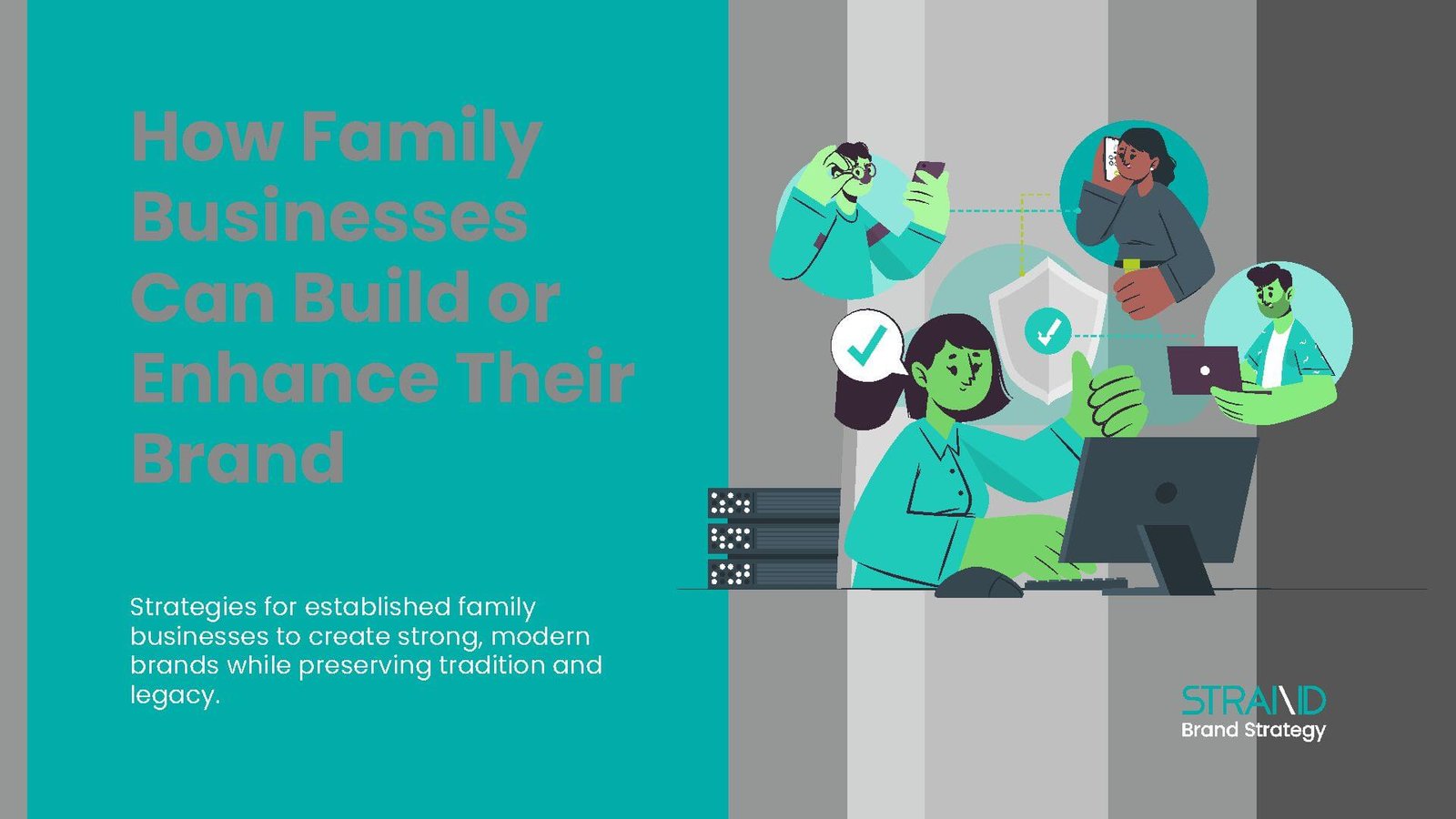How Family Businesses Can Build or Enhance Their Brand
7 minutes | 08 Nov 2024Strategies for established family businesses to create strong, modern brands while preserving tradition and legacy.
Family businesses have always played a pivotal role in shaping economies and communities around the world. Many of these businesses are rich in history and tradition, having been passed down through generations. However, in today’s dynamic and competitive market, even the most established family-owned enterprises must evolve to stay relevant. While preserving their heritage is crucial, these businesses also need to build or enhance their brand in a way that resonates with modern consumers.
Branding, once seen as a marketing tool, is now a strategic asset that defines how a business is perceived in the market. For family businesses, creating or enhancing a brand is not just about logos and taglines—it’s about communicating a narrative that blends tradition with innovation, credibility with relevance, and legacy with modernity.
In this article, we explore how family-owned businesses can successfully build or enhance their brand while maintaining their unique identity and legacy. We will discuss the challenges they face, the importance of strategic alignment, and practical steps to create a powerful brand that stands the test of time.
The Importance of Branding for Family Businesses
Branding for family businesses refers to the strategic creation or enhancement of the business’s identity, encompassing its values, story, and offerings. A well-defined brand allows family businesses to differentiate themselves in a crowded marketplace, create a lasting connection with customers, and align their traditional values with the expectations of today’s consumers.
According to a report by PwC, family businesses that prioritize branding and digital transformation are 60% more likely to achieve sustained growth. In a globalized market where competition is fierce, a strong brand gives family businesses an edge, especially as more consumers seek out businesses with authentic values and meaningful stories. Research also shows that 79% of consumers are more likely to buy from companies whose brands they trust, making branding a key driver of customer loyalty.
For family businesses, the brand is often an extension of their legacy, values, and community standing. However, to thrive in the modern economy, these businesses must also adapt to contemporary consumer preferences, such as sustainability, digital presence, and innovation. A powerful brand bridges the gap between tradition and modernity, allowing family-owned enterprises to stay relevant while maintaining their identity.
The Tata Group in India is an excellent example of a family business that has built a strong brand by blending tradition with innovation. Rooted in its founding principles of trust and community service, Tata has successfully adapted its brand to meet the needs of modern consumers through technological advancements, sustainability initiatives, and global expansion, while maintaining its core values.
Challenges Family Businesses Face in Building or Enhancing Their Brand
Family businesses face unique challenges when it comes to branding, which can complicate their ability to create or enhance their image effectively.
- Balancing Tradition with Innovation:
One of the most significant hurdles is finding a balance between preserving the family legacy and embracing innovation. Many family businesses are deeply rooted in their traditions, making it difficult to adopt new marketing trends, digital tools, or modern communication strategies that could benefit their brand. - Generational Conflicts:
Family businesses often span multiple generations, and each generation may have a different vision for the company’s brand. The older generation may prioritize maintaining the company’s historical identity, while younger members may advocate for modernization and digital transformation. This can create internal friction and slow down the process of brand development. - Resource Constraints and Risk Aversion:
Family businesses may not have access to the same resources as large corporations, making it challenging to invest in comprehensive branding strategies. Additionally, risk aversion, especially in older generations, may prevent businesses from trying new branding techniques or expanding into digital marketing channels.
While these challenges can be significant, they also present opportunities. Modernizing a family brand does not mean abandoning tradition; it’s about incorporating new elements into a brand’s existing identity to make it more appealing to current audiences. The key is to view branding as an investment in the future, ensuring the business’s longevity and relevance.
Building or enhancing a family business’s brand has far-reaching implications for stakeholders, including customers, employees, and the community. For example, modern branding initiatives that prioritize transparency, sustainability, or community involvement can strengthen relationships with these groups and foster loyalty.
Ferrero Group, the Italian confectionery company known for brands like Nutella and Ferrero Rocher, is an example of a family business that has overcome branding challenges. Despite its global expansion, Ferrero has remained committed to its family values and traditions while continuously evolving its brand to cater to modern consumers through sustainable practices and innovative marketing.
Strategies for Building or Enhancing a Family Business Brand
Family businesses can adopt several strategies to build or enhance their brand while staying true to their heritage.
- Leverage the 5S Framework for Brand Strategy
STRAND’s 5S Framework—Aspirations, Analyses, Alignment, Awareness, and Actions—provides a structured approach for family businesses to modernize their brands without losing sight of their legacy:- Aspirations: Define the long-term vision for the family business. Clarify how the brand aligns with the company’s core values and family traditions.
- Analyses: Conduct a thorough analysis of market trends, consumer expectations, and competitors. Use tools like SWOT or STEEPLE analysis to identify branding opportunities.
- Alignment: Ensure that all family members and internal stakeholders are aligned on the brand’s future direction. Build consensus across generations to avoid conflicts and create a unified branding approach.
- Awareness: Develop targeted brand messaging that resonates with today’s consumers while highlighting the unique heritage of the family business.
- Actions: Implement branding initiatives that reflect both tradition and innovation, whether through digital marketing campaigns, sustainability efforts, or community engagement.
- Tell the Family Story
Family businesses have a unique advantage: a rich history that can be woven into their brand narrative. Emphasizing heritage, values, and the family’s role fosters trust and authenticity, essential for appealing to modern consumers’ preferences. Sharing the business’s founding story, milestones, and challenges creates an emotional connection with customers, enhancing brand loyalty and engagement. - Embrace Digital Transformation
To remain competitive, family businesses must embrace digital tools and platforms. This includes having a strong online presence, leveraging social media, and engaging in content marketing. These strategies allow family businesses to reach younger, tech-savvy audiences without compromising their core values. Additionally, investing in e-commerce and digital advertising can significantly enhance brand visibility. - Commit to Sustainability and Community Engagement
As consumers increasingly seek brands that stand for something meaningful, family businesses should highlight their commitment to sustainability, ethical practices, and community involvement. Align initiatives with the family’s values to position the business as a responsible brand that resonates with modern consumers.
Levi Strauss & Co., though no longer entirely family-owned, still leans on its family-oriented roots in its branding. Levi’s has maintained its heritage as a pioneering denim company while reinventing itself as a leader in sustainable fashion. Levi’s integrates its legacy with innovation, successfully building a brand that resonates with both older and younger generations alike.
The future of family businesses lies in their ability to blend tradition with innovation. As younger generations step into leadership roles, they will bring fresh perspectives on digital transformation, sustainability, and customer engagement. Family businesses that embrace these changes while honoring their legacy will continue to thrive in the global marketplace.
Family businesses are uniquely positioned to build powerful, enduring brands. Their rich heritage and deep-rooted values offer authenticity and trust, qualities that resonate with today’s consumers. However, to remain competitive and relevant, family businesses must evolve. By embracing strategic branding and digital tools, family businesses can balance tradition with innovation, reflecting legacy while driving future growth.
Successful branding for family businesses hinges on aligning past and future, family values, and modern consumer expectations across generations.
Are you looking to enhance your family business’s brand? STRAND offers tailored branding workshops designed to help family businesses strengthen their identity and position themselves for long-term success. Contact us to learn more about how we can support your journey from legacy to modern brand excellence.

